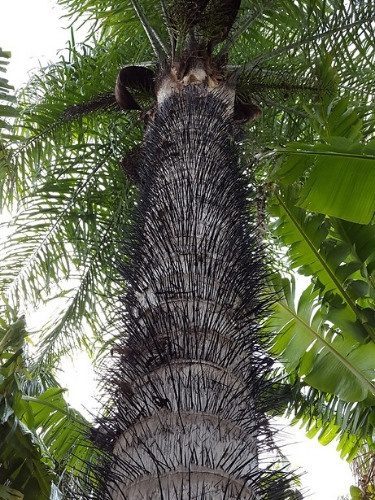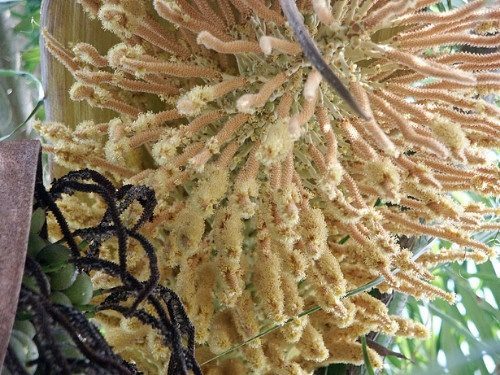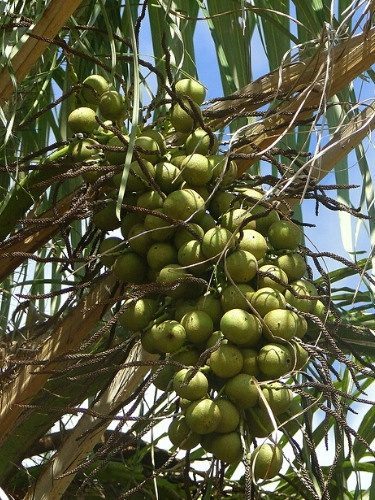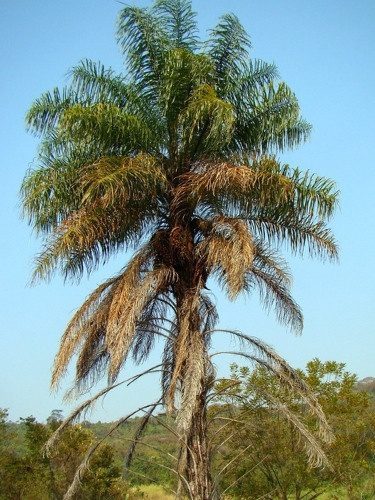
The macaw palm is a fruit-bearing tree of significant practical and ornamental value, characterized by long thorns along its stem. It is native to the Americas, thriving in tropical and equatorial forests. Its solitary stem, known as a stipe, is ringed, spiny, and partially covered by leaf sheaths from the leaves that have shed. The stipe has a diameter of about 11.8 inches and can reach heights of up to 49.2 feet. The dark thorns on the stem are sharp, horizontal, and can grow up to 2.8 inches long. The green leaves of the macaw palm measure from 4.9 to 9.8 feet in length. They are pinnate, covered in thorns, alternate in arrangement, and consist of long linear leaflets at various angles, giving the leaves a feathery appearance.
The inflorescences are panicles with bracts, emerging in the spaces between the leaves during spring and summer. They can grow up to 31.5 inches in length and emit a strong fragrance. The small, numerous flowers are yellow, with female flowers at the base and male flowers at the distal portion of the inflorescence. Pollination primarily occurs through bees and beetles. Its edible fruit, resembling a globular drupe, ripens in autumn. These fruits, with a green-yellow hue, can reach up to 2.4 inches in size and contain one to four large, oily seeds. These seeds yield a fine, transparent oil. Birds like macaws, parrots, toucans, finches, and parakeets are attracted to this palm. Additionally, the palm heart of this species is considered a delicacy.

The macaw palm is highly ornamental, with a crown resembling a beautiful arrangement of feathers that sway with the breeze. It’s perfect for use in contemplative spaces meant to be admired from a distance, but it’s advisable to keep it away from paths and areas with heavy pedestrian traffic, especially children.
The sharp thorns give it an exotic beauty while posing a risk for accidents. Removing the thorns should be avoided, as it would alter the unique and interesting appearance of this palm. Furthermore, transplanting this species requires extreme care to avoid damaging the layer of thorns, which can leave indelible holes in the stem. It can be used individually, in groups, or as hedgerows, enhancing a tropical character in settings such as estates, farms, parks, and extensive corporate gardens. Moreover, it attracts tropical birds that add extra interest to the garden and aid in seed dispersal.
Beyond its landscaping use, the macaw palm is a plant of myriad utilities. Every part of it is valuable: The oil extracted from its fruit can be used in gastronomic preparations as a substitute for olive oil, as well as in the cosmetic industry or biodiesel production. Its heart yields nutritious starch, and the hard stem wood can find applications in construction or rural settings. The leaves can serve as fodder for livestock and also provide textile fibers used in making nets and fishing lines.

It should be cultivated under full sun and thrives in very fertile, well-draining soils. If grown in pots, regular watering to maintain slightly moist soil without waterlogging is essential. Once established in the garden, supplementary watering should be provided during dry spells. Fertilize every 6 months with organic matter and palm-specific fertilizers. It enjoys tropical heat and humidity, not tolerating colder temperatures below 19.4°F.
Maintenance involves carefully removing old leaves to preserve its distinctive thorns. Propagation is done through seeds, which should be germinated in sandy, organic-rich soil. The seeds are recalcitrant, resulting in slow and uneven germination, which can take several years. Despite having a low germination rate, this species can live up to 100 years. Fruiting typically begins about 3 to 5 years after germination.

